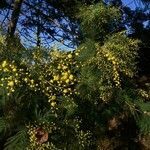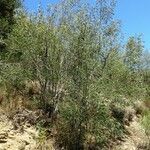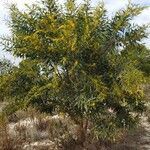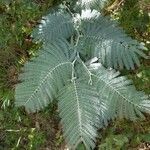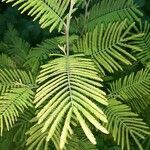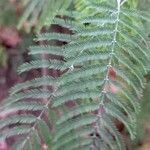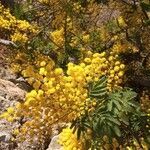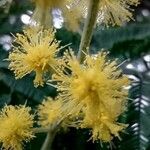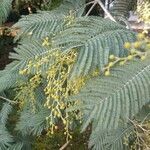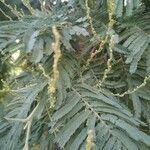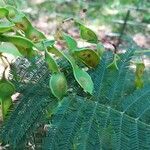Bushy shrub or spreading tree to 30 m high. Bark smooth, grey, brown or dark brown, deeply corrugated when old. Branchlets slightly angular with ridges, densely puberulous, usually pruinose. Young foliage-tips white, cream-coloured to golden, velvety-tomentose. Leaves herbaceous, usually bluish grey or silvery and glaucous; petiole to 1.5 cm long, slightly ridged, with apical gland; rachis 1–12 (–17) cm long, with one orbicular light to dark brown tomentellose jugary gland at each pair of pinnae; interjugary glands absent; pinnae 6–30 pairs, 0.5–5.5 cm long; pinnules 10–68 pairs, narrowly oblong to linear, 0.7–6 mm long, 0.4–0.8 (–1) mm wide, ± glabrous or puberulous on upper surface, silvery-puberulous below, obtuse or truncate. Inflorescences in axillary racemes, or mostly terminal or axillary false-panicles; axes often zig-zagged. Peduncles 2–10 mm long, hairy. Heads globular, 13–42-flowered. Pods often slightly constricted between some or all seeds, 2–11.5 cm long, 6–14 mm wide, subcoriaceous, blue or purplish, pruinose.
Shrubs or trees, small, ca. 15 m tall, unarmed. Young branchlets slightly angular with ridges gray tomentose, glaucous. Leaves argenteous to greenish or golden when not extended; rachis not angulate; glands at rachis of pinna insertion; pinnae 10-20(-25); leaflets 26-46 pairs, dense, distance between leaflets not more than width of 1 leaflet, linear, 2.6-3.5 × 0.4-0.5 mm, abaxially or both surfaces gray-white pubescent. Heads 6-7 mm in diam., arranged in axillary racemes or panicles; peduncles ca. 3 mm. Flowers yellowish or orange-yellow. Legume red-brown or black, glaucous, oblong, flat, 3-8 cm × 7-12 mm, glabrous. Seeds elliptic, flat. Fl. Apr, fr. Jul-Aug. 2n = 26.
Tree or shrub, 5-15 m high, branchlets shallowly ridged, tinged grey or purple. Bark grey-brown to blackish, smooth, later rough. Branches hairy, yellowish when young, later grey. Leaves bipinnate, silvery-grey, glaucous, finely hairy, 20-50 mm long, rachis 25-100 mm long, pinnae 10-26 pairs, each with 17-50 leaflet pairs. Flowers globular heads in axillary racemes, bright yellow. Flowering time July, Aug. Pod brown, 30-80 x 7-13 mm, straight or slightly curved, dehiscent.
A tree. It grows 30 m tall. The bark is smooth and grey. The twigs and young leaves have silvery hairs. The leaves are twice divided. They are bluish-green. They have 8-10 pairs of primary divisions and then many small narrow leaflets. The flowers are bright yellow. They are in small 5-6 mm heads. These make up large panicles at the ends of branches. The pods are narrow and 40-100 mm long. They are flattened and brown with a bluish bloom.
Shrub or tree, up to 15 m high; with a rounded crown; unarmed. Leaves with leaf rachis with gland at junction of all or most pairs of pinnae but not between pinnae pairs; leaflets 1.55.5 mm long. Flowers: inflorescence capitate; corolla bright yellow; Jul.-May. Pods not or slightly moniliform, dehiscing longitudinally along one margin only.
Unarmed, evergreen tree, 5-15 m, branches with velvety-hairy growth tips, initially yellow, turning greyish or white. Leaves bipinnate, silvery grey, finely hairy. Flowers in globose heads, pale to bright yellow. Pods greyish or purplish brown, slightly constricted between seeds.
Leaves: petiole (0.5)1-2 cm. long, eglandular; rhachis 2.5-9.5 cm. long, with a raised gland above at the junction of each pair of pinnae, but without other glands in between as in A. mearnsii; pinnae (5)12-26 pairs; leaflets in 17-50 pairs, 2.5-5.5 x 0.4-0.7 mm., linear-oblong.
Unarmed shrub or tree, up to 15 m high. Leaf rhachis with gland at junction of all or most pairs of pinnae but not between pinnae pairs; leaflets 1.5-5.5 mm long. Pods not or slightly moniliform. Flowers bright yellow.
Shrub or small tree 2.5-10 m. high, rarely more; young branchlets usually densely short-pubescent, rarely subglabrous, and also ± grey-pruinose; pubescence grey, or yellowish at first then grey.
Leaf-rachis internodes eglandular; leaflets (2-)2.6-3.5 mm, apex often subacute. Pod 7-9(-12) mm wide, glabrous, usually glaucous
Flowers bright-yellow, in heads 4-7 mm. in diam. on peduncles up to 6 mm. long, panicled or racemose.
Seeds brown to blackish-brown, 5-6 x 3-3.5 mm.; caruncle conspicuous; areole 3.5-4 x 0.75-1.5 mm.
Pods dehiscent along one margin, 3-8 x 0.7-1.3 cm., not or only slightly moniliform.
